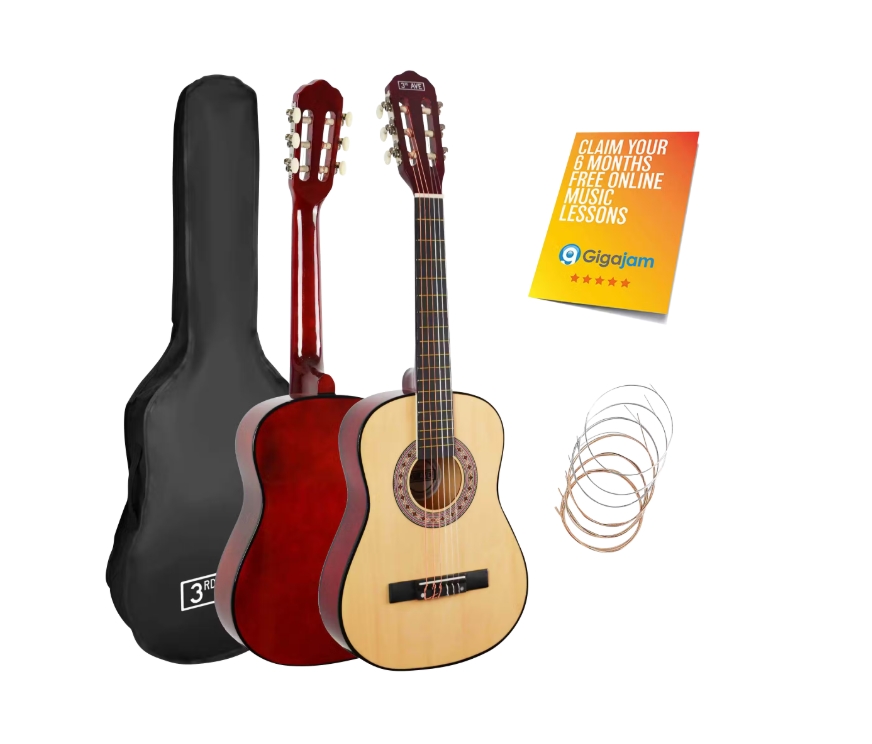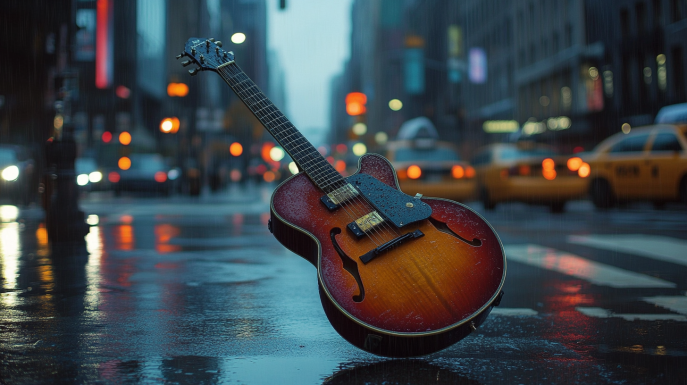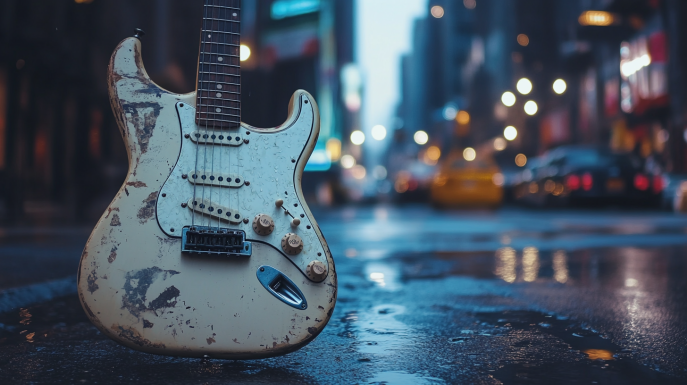
3rd Avenue Classical Guitar 1/2 Size Natural Set
- The 3rd Avenue 1/2 Size Classical Guitar pack is tailor made for beginners and students. A great choice for someone after their first guitar without breaking the bank.
Everything You Need to Know Before Buying a 3rd Avenue Classical Guitar
The 3rd Avenue classical guitar has become one of the most popular beginner and intermediate classical guitars on the market today. Known for its high-quality construction, warm tone, and affordable price point, the 3rd Avenue nylon-string classical guitar is an excellent choice for any player looking to buy their first serious classical guitar or upgrade from a budget beginner’s instrument.
But with so many options, sizes, and configurations available, it can be tough to know which specific 3rd Avenue classical guitar is right for your needs and budget. This in-depth buying guide will walk you through everything you need to know before purchasing a 3rd Avenue classical guitar so you can find your perfect match!
The Quality and Craftsmanship of a 3rd Avenue Classical Guitar
3rd Avenue classical guitars are constructed in China and Indonesia using solid tonewoods and high-quality materials. The back and sides are made from mahogany or rosewood while the tops are typically solid cedar or spruce, helping provide an articulate, balanced tone. The quality control from the 3rd Avenue manufacturer is impressive – most guitars are set up well right from the factory with good action and playability.
The craftsmanship and attention to detail belies the affordable price point. The guitars feature detailing like wood binding, pearl inlays, and mosaic wood rosettes. The neck is set for proper action and adjustment, and the machine heads keep the strings in tune well. The fretwork on the neck is generally nicely crowned and finished. Overall the fit and finish is fantastic for a classical guitar under $500.
The end result is a budget classical guitar that looks, plays, and sounds like a far more expensive instrument. While not at the level of a handmade luthier classical guitar, the 3rd Avenue nylon-string guitars certainly exceed expectations and rival other major brands costing twice as much.
Cost and Budget for a 3rd Avenue Classical Guitar
3rd Avenue offers classical guitars ranging from about $179 to $449 in price, making them an excellent value proposition. Even their most affordable models offer all solid wood construction and a quality setup.
As you go up in price, you’ll gain improvements in things like solid cedar or spruce tops, deeper body sizes, and finer appointments like inlays and binding. However, even the most budget-friendly 3rd Avenue classical models make for fantastic beginner instruments, or backups for more advanced players.
Here’s a quick overview of what to expect at different price points from 3rd Avenue:
- Under $200 – Great for new players or travel guitars. Laminate wood back and sides.
- $200-$300 – Best-sellers with solid tonewood construction. Robust warm tone.
- $300-$400 – Intermediate models with cedar/spruce tops and appointments like binding.
- Over $400 – Pro-level specs like Indian rosewood backs, mosaic rosettes, thicker bodies.
No matter your budget, a 3rd Avenue classical guitar will offer good value and quality consistent with its price. Make sure to factor in the cost of a case, strings, and any other accessories you may require as optional additions to the guitar’s purchase price.
The 3rd Avenue Classical Guitar for Beginners
The high-quality yet forgiving playability makes a 3rd Avenue classical guitar a fantastic choice for beginners. The slender classical neck and nylon strings are easier on the fingers than steel-string acoustics, letting students build skills without pain. A wider nut width provides room between strings for clearer fingerings.
Many 3rd Avenue classical models come in a range of sizes to accommodate players young and old, small and large. From 1/2 and 3/4 sizes for kids up to full-size and deep-bodied guitars for adults, you can find the right fit. This makes it simpler to hold proper classical technique.
Onboard electronics on some models allow for quiet practice by plugging headphones right into the guitar. The affordable pricing also reduces worry about damage as students progress. Overall if you’re looking to buy your first classical guitar or start lessons, you can’t go wrong with a quality 3rd Avenue.
Where to Buy a 3rd Avenue Classical Guitar
3rd Avenue guitars are sold through various online retailers and local music stores. Buying from an authorized dealer ensures you receive a genuine instrument with the factory warranty.
Top national retailers like Guitar Center, Sam Ash, and Musician’s Friend carry 3rd Avenue classical guitars in many sizes and configurations. You can even find them commonly on Amazon and other online stores.
Local musicians may want to check smaller music shops in their area. Trying guitars in person is ideal for feel and sound, though not all physical stores will stock them. In some cases you may need to special order a 3rd Avenue guitar through your local retailer.
Used models can also be found from private sellers on sites like Craigslist, eBay, and Reverb. Just be diligent in inspecting any used classical guitar for damage before purchasing.
Key Features of the 3rd Avenue Classical Guitar
Here are some of the most important features that make the 3rd Avenue classical guitar so popular:
- Solid tonewood construction – Back, sides, and top made from solid mahogany, rosewood, cedar, or spruce for resonant warm tone.
- Nylon strings – Easier on fingers without digging in like steel strings. Produces mellow classical tone.
- Wider nut width – Around 52-54mm nut allows more room between strings for easy finger placement when reading notation.
- Textured fingerboard – Satin finish on neck provides smooth playability and avoids “sticking” while bending strings.
- Pin bridge – Provides crisp, bright transfer of string vibrations for balanced tone across registers. Allows easy changing of strings.
- Multiple sizes – Various body shapes and sizes accommodate players of all ages, body types, and experience levels.
- Onboard electronics – Some models feature built-in pickups and preamp for quiet practice with headphones. No amp needed.
- Stylish detailing – Pearl inlays, mosaic rosette, and body/neck binding give an elegant refined aesthetic.
How the 3rd Avenue Compares to Other Brands
The 3rd Avenue classical guitar stands up well when compared to other big classical guitar manufacturers in its price range like Cordoba, Yamaha, and Alvarez. The quality control and attention to setup gives 3rd Avenue an advantage at every tier.
Against other budget classical guitars under $300 from Fender, Jasmine, or Rogue, the 3rd Avenue simply can’t be beaten. You would need to spend at least twice as much to get a major step up in sound and playability.
When evaluating mid-range classical guitars around $500-1,000, established brands like Kremona or Takamine may edge out 3rd Avenue, but only slightly. For about half the cost, the 3rd Avenue gets you about 90% there in terms of tone, volume, and refinement.
Only at the professional tier of hand-made classical guitars from luthiers will you find instruments undoubtedly superior to a 3rd Avenue classical. But you can buy several 3rd Avenue models for the cost of one custom classical guitar.
Ultimately, the 3rd Avenue classical guitar competes with guitars well above its price range while retaining an amazing value proposition. No other classical guitar brand gives you such quality and craftsmanship for the money.
Choosing the Best Strings for Your 3rd Avenue
3rd Avenue classical guitars come standard with a decent set of nylon strings, typically Savarez or D’Addario Pro Arte. However many players may want to experiment to find their perfect string set. Here are some top options:
- Savarez 500CJ – One of the most popular classical sets with a warm, balanced tone. The high tension creates crisp articulation.
- D’Addario Pro Arte – An affordable nylon set praised for its excellent intonation across the fretboard. Ideal balanced tension for most players.
- Augustine Regal – These premium nylon strings have unparalleled warmth and resonance. Made from rectified materials for superb tuning stability.
- Hannabach Gold T5 – A top seller with polished silver-plated wound bass strings for maximum volume and sustain. Great for performance.
- Aquila Nylgut – Synthetic gut core strings loved for their quick, easy feel on fingers. Help build endurance for long practice sessions.
Be sure to choose the right classical string gauge based on your 3rd Avenue guitar’s construction. Lighter tension sets work well on smaller bodied guitars while bigger models can handle the denser treble and bass of hard tension strings. Mix and match to craft your perfect classical guitar voice!
What Comes in the Box with a 3rd Avenue Classical?
3rd Avenue aims to provide everything you need to start playing right out of the box:
- Gig bag – Basic soft-shell case to protect from bumps and dust. Upgrade to a hardshell case for serious protection.
- Spare strings – Usually includes an extra set in addition to the installed strings.
- Bridge pins – Extra pins are handy for string changes or replacing damaged pins.
- Pickguard – Thin protective plastic or tortoiseshell pickguard below the soundhole.
- Tuning wrench – For tightening and adjusting the machine heads if strings slip out of tune.
- Polishing cloth – Maintain the glossy finish by gently wiping down after playing.
While no other accessories like a strap, picks, or stand come standard, the included basics get you playing quickly right out of the box. Be sure to pick up a tuner, footstool, music stand, and metronome to round out your beginner classical gear.
How to Tune and Care for Your 3rd Avenue Classical Guitar
Tuning and maintaining your 3rd Avenue classical guitar helps it sound and play its best for years to come. Follow these tips:
- Use an electronic tuner for accurate tuning – match the displayed pitches by turning the machine heads. The strings from thickest to thinnest are E, A, D, G, B, E.
- Tune up to pitch gradually – Don’t tighten strings more than a half or whole step at a time to avoid damage or breakage.
- Check tuning before each practice – With nylon strings, tuning can drift more over time or with changes in temperature and humidity.
- Clean strings after playing – Wipe down the strings with a soft dry cloth to remove dirt, oil, and skin particles which can deaden tone.
- Trim and file nails – Keep fingernails short and smooth to avoid scratching the finish or pulling up on the strings.
- Add humidity control – Use room humidifiers during dry seasons or climates to prevent the wood from cracking or warping due to lack of moisture.
- Clean the body – Wipe the body down gently with a microfiber cloth after playing. Polish it every few weeks to keep the finish glossy.
Taking proper care of your 3rd Avenue will keep it sounding its absolute best season after season as you progress on your classical guitar journey. Maintaining the health and cleanliness of both strings and body will let this instrument mature like a fine wine!
Classical Guitar vs. Acoustic – What’s the Difference?
Though similar looking, there are a few key differences that distinguish the classical guitar from its steel-string acoustic cousin:
- Nylon vs steel strings – Nylon classical strings are mellower in tone and easier on the fingers than steel acoustic strings.
- Wider neck – Classical necks are about 2″ across at the nut vs 1-11/16″ for acoustic. Allows more room between strings.
- Nylon string spacing – Classical strings are spaced farther apart for clearer melodic lines and chords without brushing adjacent strings.
- Supportive bracing – Classical guitars use fan bracing for maximum vibration and sustain. Acoustics use X-bracing for durability.
- Right hand technique – Classicals use the fingernails versus a pick for most styles. Acoustics incorporate both.
- Musical styles – Most classical music uses notation versus playing by ear on acoustic. Fingerpicking approaches differ.
- Body shapes – Classical bodies are rounded versus the squarer dreadnought acoustic shape. Cutaways are less common.
While there is certainly overlap, the classical guitar and acoustic are optimized for different playing techniques and musical genres. The 3rd Avenue classical shines when played in its element – reading notation and performing classical fingerstyle compositions.
Available Sizes of the 3rd Avenue Classical Guitar
From small children to large adults, 3rd Avenue offers classical guitars in a range of sizes:
- 1/2 size – 30″ length. For ages 5-8. Easier playability for tiny hands.
- 3/4 size – 34″ length. Ages 8-12. Lets younger kids hold proper technique.
- 7/8 size – 36″ length. Ages 10-14. A transition guitar before full size.
- Full size – 40″ length. Standard classical guitar size for most teens or adult players.
- Full size cutaway – Same length but with a cut body for easier upper fret access.
- Full size plus – 42″ length. Extended body depth provides fuller bass.
The most common recommendation is choosing the smallest guitar that lets you hold proper playing form – hugging the body with your right arm, and able to comfortably fret notes on the lower frets without overextension. A teacher or salesperson can help find the ideal size.
The Playability and Durability of 3rd Avenue Guitars
3rd Avenue classical guitars deliver fantastic playability right out of the box thanks to quality craftsmanship. The action, fretwork, neck relief, and overall setup are impressively dialed in. Strings are easy on the fingers without digging in like steel strings can.
The use of all solid tonewoods also gives them greater stability in withstanding string tension compared to laminate constructions. The neck joint and bracing keep the guitar true over seasons and years of play.
Hardware like the tuning machines and bridge hold up well to regular tuning and string changes. The finish resists chipping or yellowing if the instrument is cared for. Overall 3rd Avenue guitars are built to last and stand up to regular practice and amateur performance use.
While maybe not as indestructible as an all-laminate kid’s guitar, the solid wood 3rd Avenue classical can take accidental bumps or drops and still look great. For the price, it’s hard to find more durable classical guitars without paying over $1,000. Take proper precautions, and a 3rd Avenue will last decades!
Using the 3rd Avenue for Flamenco and Fingerstyle
While designed with traditional classical technique in mind, the 3rd Avenue classical can certainly be used for other fingerstyle genres:
Flamenco – A 3rd Avenue classical matches the bright, percussive tone required for flamenco playing. Using specialized flamenco strings can further accentuate the crisp rhythms.
Fingerpicking – The wider classical neck provides more room for complex fingerstyle arrangements than a steel-string acoustic. Nylon strings help intricate patterns sing out clearly.
A skilled player could use a 3rd Avenue classical for folk, country, jazz, or most any fingerstyle genre. It may not punch through a mix like a steel-string would, but for solo playing or small groups, the softer nylon sound provides a wonderful accompaniment.
Try out different picking areas and angles near the bridge or over the soundhole to shape your ideal fingerstyle tone. And use a lighter touch compared to digging in with a pick for the most expressive dynamics. The only limit is your creativity!
Reviews of the 3rd Avenue Classical Guitar
The 3rd Avenue classical consistently earns high praise across various reviews:
- “Fantastic bang for your buck – You’d expect a guitar this nice looking and playing to cost 3 times as much!”
- “My new favorite practice guitar – The smooth nylon strings let me play for hours without hurting my fingers.”
- “Perfect for new classical players – It came tuned up nicely and has a full classical sound right from the start.”
- “Holds tune surprisingly well – I only have to do minor tune adjustments before each practice session.”
- “Easy on the fingers for complex pieces – The wider neck and string spacing help me cleanly fret tricky chord shapes.”
- “Sounds amazing plugged in – I can practice late at night by plugging in my headphones with the built-in pickup.”
- “Quality setup right from the factory – The action and intonation was near perfect out of the box.”
Most reviewers agree you’d be hard pressed to find a better classical guitar value. The quality and price make the 3rd Avenue an ideal first classical guitar, or a worthy upgrade for seasoned players on a budget.
Caring for Your 3rd Avenue Guitar
Regular cleaning and maintenance keeps your 3rd Avenue classical guitar looking, playing, and sounding its very best:
- Clean the strings after playing with a dry soft cloth to remove skin oils and dirt buildup.
- Wax or polish the body/neck every few weeks to prevent dust buildup and retain the glossy finish.
- Check for string grooves in the nut and bridge – these can cause tuning problems if too deep.
- Inspect the fret ends to make sure they aren’t poking out past the edge of the fretboard. File down if needed.
- Tighten any loose tuning pegs by tightening the screw in the tuning machine. Add peg drops if tuning is still slipping.
- Humidify the guitar during drier seasons to prevent cracks or seams from low humidity.
- Loosen strings before doing any adjustments to avoid excessive string tension.
With occasional cleaning an maintenance, your 3rd Avenue classical guitar will age gracefully and provide many years of trouble-free play.
The 3rd Avenue Classical for Smaller Hands
The 3rd Avenue classical guitar is an excellent choice for players with smaller hands, especially youth and children. The wide range of sizes available ensures you can find the perfect fit. Even the full-size models are very playable thanks to these advantages:
- Shorter scale length – The 25.6″ scale length is shorter than a steel-string acoustic guitar, making it easier to fret notes.
- Narrower neck – The classical neck width at the nut is just over 2″ compared to 1-11/16″ for a steel-string.
- Light string tension – Nylon classical strings have less tension than steel strings, reducing fatigue in smaller hands.
- String height – The action can be lowered for comfortable playing without buzzing.
- Nylon is flexible – Nylon strings can bend and vibrate easily under lighter pressure from small fingers.
Kids and smaller hands can focus on proper classical technique rather than struggling with thicker strings and higher action. Go with a 3/4 or even 1/2 size model to start for the best experience. The 3rd Avenue classical makes playing easier and more enjoyable.
Woods and Materials Used in 3rd Avenue Classical Guitars
3rd Avenue classical guitars are constructed from solid tonewoods which give them an authentic resonant voice:
Spruce – This light yet strong softwood is the most common choice for classical guitar tops. Provides crisp, articulate highs and excellent volume.
Cedar – A warmer alternative to spruce with sweet overtones. Cedar tops respond well to fingerstyle playing.
Mahogany – Mid-range focused tone. Affordable, durable, and resonant. The most common wood for backing and sides.
Rosewood – The premier classical guitar back/side wood. Dense and reflective for extremely complex harmonics. Pricey.
Ebony – Fretboards are usually ebony for hardness and smooth feel. Ebony binding and bridge pins also common.
Maple – Occasionally seen for necks and fretboards. Stiff and bright. Provides excellent sustain and stability.
The all-solid-wood construction of 3rd Avenue classicals allow the unique tone of each wood to ring through. Combined, these tonewoods produce a balanced, nuanced classical guitar voice.
The Sound Quality and Volume of the 3rd Avenue Classical
The 3rd Avenue classical guitar delivers a rich, warm, resonant classical tone thanks to its all-solid wood body. The cedar and spruce tops produce rounded highs with crisp articulation. Mahogany or rosewood backs add complex midrange overtones.
Volume is impressive thanks to the fan bracing maximizing vibration. While not as punchy as a steel-string acoustic, a 3rd Avenue classical projects very nicely for solo or small ensemble playing. The tone is nicely balanced across the registers – lows are full but not boomy, and highs ring out with sweetness, not brittleness.
Many musicians are impressed by how close the 3rd Avenue classical gets to the sound of guitars costing twice as much. While not 100% as complex and refined as an expensive luthier classical, it’s about 85-90% there – very impressive for the affordable price point.
Between the resonant woods and quality construction, the 3rd Avenue classical guitar definitely defies its budget price tag with a professional-grade classical guitar tone.
What Comes in the 3rd Avenue Classical Starter Kit?
For new classical guitarists, 3rd Avenue bundles a number of accessories in one convenient starter kit. A typical 3rd Avenue classical guitar starter kit includes:
- 3rd Avenue classical guitar (full size or smaller)
- Two extra sets of nylon strings
- Two guitar picks (for electric/acoustic guitars)
- Clip-on tuner
- Guitar strap
- Guitar gig bag or case
- Instructional DVD or book
- Pitch pipe or smartphone tuner app
- Some include a small practice amp
The starter kit bundles everything a beginner needs to get up and running. All that’s missing is a music stand for reading notation, and a footstool for proper posture.
With the quality 3rd Avenue classical as the centerpiece, the extra strings, tuner, training materials, and other goodies round out a great starter set. It takes the guesswork out of sourcing all the right beginner classical gear.
Left-Handed 3rd Avenue Classical Guitars
While less common that the standard right-handed orientation, many 3rd Avenue models are offered specifically in left-handed versions. Lefties will appreciate that 3rd Avenue doesn’t simply flip a right-handed model.
Instead, the left-handed models are built from scratch to properly accommodate a lefty playing style. The bracing and bridge position is optimized for ideal resonance when strung for a left-handed player.
Availability of left-handed models does vary by retailer. Musician’s Friend has the widest selection of 3rd Avenue left-handed classical guitars, in all sizes from 1/2 to full-size. Guitar Center also carries some lefty models. Check with your local shop as well.
Call ahead to confirm inventory if going to test out a lefty 3rd Avenue classical in person. But rest assured that 3rd Avenue has not forgotten about southpaws! With a properly set up left-handed classical guitar, lefties can enjoy the same quality experience as right-handed players.
In summary:
For classical guitarists of all levels, the 3rd Avenue nylon-string guitar line represents an unmatched combination of playability, solid construction, and value. Models are available for players of all ages and hand sizes to learn on an optimally fitted instrument.
Compared to budget all-laminate guitars or expensive hand-built classics, the 3rd Avenue hits a sweet spot both in terms of cost and performance. While every guitarist’s needs are subjective, you’ll be hard pressed to find a more well-rounded affordable classical guitar than those offered by 3rd Avenue.





